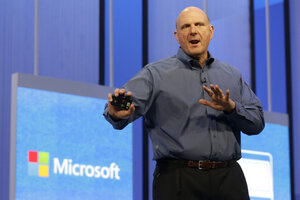At Build 2013, Microsoft unveils Windows 8.1 (complete with Start button)
Microsoft showed off Windows 8.1, the first major update to its computer/tablet operating system, at the Build developer conference on Wednesday.

Microsoft previewed Windows 8.1, an update to its flagship operating system, at the Build developers conference this week. Here, Microsoft chief executive Steve Ballmer addresses the crowd at the conference.
Jeff Chiu/AP
With Windows 8, Microsoft’s aim was to make an operating system that offered more or less the same experience on computers, tablets, and hybrid devices alike -- but many early adopters found the software confusing, since it contained features and design cues that didn’t make sense on all devices. With Windows 8.1, the first major update to the OS, Microsoft is bringing back familiar features that had originally been discarded, while doubling down on the idea that the OS can work equally well on a computer or a tablet.
At the Microsoft Build developer conference this week, chief executive Steve Ballmer said Windows 8.1 is a way for the company to “reblend the desktop and modern experience,” and that the company is responding to many computer users who wanted the new software to incorporate more familiar elements.
The venerable Start button is the most noticeable inclusion in Windows 8.1 -- it doesn’t behave the same way it did in previous versions of Windows, but it does allow users to access the Control Panel and Task Manager, and restart or shut down the device. Windows 8.1 can also boot straight to the desktop, bypassing the Modern UI tiles that make up a big part of the interface. (Those tiles are great if you’re using a touchscreen, but many users complained that they don’t make sense with a keyboard and mouse.)
Microsoft added polish to the more modern parts of Windows 8.1, too. It includes support for high-resolution displays, which means that high-end devices such as Microsoft’s own Surface Pro won’t display tiny text and small buttons anymore. Many of the Windows 8 apps have received updates -- Microsoft redesigned the Mail and Xbox Music programs -- and the OS itself can be made more personal, too. At the conference, Microsoft demoed the ability to show photos on the login screen, add personalized backgrounds, and organize Windows 8 tiles. There’s also a new search: Bing is now responsible for finding files both locally and on the Web, and the interface can collate text, images, audio, and video from different places.
Will Windows 8.1 bring more users into the fold? It might. In spite of Windows 8’s flaws, Microsoft’s overall strategy of creating a consistent experience across different devices is probably sound, especially as more and more touchscreen-enabled laptops and hybrid devices come to market. And those accustomed to older versions of Windows will probably appreciate seeing familiar features carry over. But we don’t know yet whether these sorts of updates -- or Microsoft’s welcomed improvements to its modern interface -- will be enough to sway large numbers of customers, or whether many folks plan to hold on to their Windows 7 computers a little longer.
Windows 8.1 will be a free upgrade for Windows 8 users, Ballmer said, and the company promised to make the software available by the end of the year. In the meantime, you can download a preview version of Windows 8.1 starting on Wednesday.
For more tech news, follow Jeff on Twitter: @jeffwardbailey.

